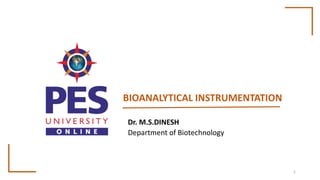
BAI PPT.ppt
- 1. BIOANALYTICAL INSTRUMENTATION Dr. M.S.DINESH Department of Biotechnology 1
- 2. BIOANALYTICAL INSTRUMENTATION INTRODUCTION M.S.DINESH Department of Biotechnology 2
- 3. Introduction to Chromatography techniques
- 4. Introduction to Chromatography technique
- 5. Introduction to Bio analytical instrumentation PRINCIPLE OF COLUMN CHROMATOGRAPHY The most powerful methods for fractionating proteins make use of column chromatography. It takes advantage of differences in protein charge, size, binding affinity, and other properties. A porous solid material with appropriate chemical properties (the stationary phase) is held in a column, and a buffered solution (the mobile phase) percolates through it.
- 6. Introduction to Chromotography Stages of separation of proteins in Column Chromatography
- 7. Introduction to Bio analytical instrumentation PRINCIPLE OF ION EXCHANGE CHROMATOGRAPHY (IEX) IEX is based on the reversible interaction between a charged protein and an oppositely charged chromatography medium. Biomolecules with even small differences in net surface charge can be separated, and very high resolution is obtained by choosing the optimal ion exchanger and separation conditions.
- 8. Introduction to Ion exchange chromatography
- 9. Introduction to Ion exchange chromatography
- 10. Introduction to Size exclusion chromatography PRICIPLE OF SIZE-EXCLUSION CHROMATOGRAPHY (SEC) Also known as Gel Filtration (GF) is the simplest and mildest of all chromatography techniques and separates molecules based on differences in size.
- 11. Introduction to size exclusion chromatography
- 12. Introduction to affinity chromatography PRINCIPLE OF PAFFINITY CHROMATOGRAPHY This is based on the binding affinity of a protein. The beads in the column have a covalently attached chemical group.
- 13. Principle of affinity chromatography
- 14. Introduction to High Performance Liquid Chromatography (HPLC) High performance liquid chromatography is now one of the most powerful tools in analytical chemistry. It has the ability to separate, identify, and quantitate the compounds that are present in any sample that can be dissolved in a liquid. Compounds in trace concentrations as low as parts per trillion [ppt] may easily be identified. HPLC can be, and has been, applied to just about any sample, Pharmaceuticals, food, nutraceuticals, cosmetics, environmental matrices forensic samples, and industrial chemicals.
- 16. Introduction to Gas chromatography The principles of gas chromatography (GC) are similar to those of HPLC The apparatus is significantly different. It exploits differences in the partition coefficients between a stationary liquid phase and a mobile gas phase of the volatilised analytes.
- 17. Components of Gas Chromatography
- 18. Introduction to Spectroscopy Spectroscopy is a scientific measurement technique. It measures light that is emitted, absorbed, or scattered by materials and can be used to study, identify and quantify those materials.
- 19. Introduction to UV Visible Spectroscopy Examples: Proteins, Polymers Molecular (sub-)structures responsible for interaction with electromagnetic radiation are called chromophores. In proteins, there are three types of chromophores relevant for UV/Vis spectroscopy: •peptide bonds (amide bond); •certain amino acid side chains (mainly tryptophan and tyrosine); and •certain prosthetic groups and coenzymes (e.g. porphyrine groups such as in haem).
- 20. Introduction to UV Visible Spectroscopy Beer’s law tells us that absorption is proportional to the number of absorbing molecules – ie to the concentration of absorbing molecules (this is only true for dilute solutions) – And Lambert’s law tells us that the fraction of radiation absorbed is independent of the intensity of the radiation. Combining these two laws, we can derive the Beer-Lambert Law: where Io = the intensity of the incident radiation I = the intensity of the transmitted radiation ε = a constant for each absorbing material, known as the molar absorption coefficient (called the molar extinction coefficient in older texts) and having the units mol-1 dm3 cm- 1, but by convention the units are not quoted l = the path length of the absorbing solution in cm C = the concentration of the absorbing species in mol dm-3
- 21. Introduction to Circular Dichroism spectroscopy Circular Dichroism, an absorption spectroscopy, uses circularly polarized light to investigate structural aspects of optically active chiral media. It is mostly used to study biological molecules, their structure, and interactions with metals and other molecules.
- 22. Principle of CD Spectroscopy
- 23. Infra-red Spectroscopy or IR Spectroscopy An invaluable tool in organic structure determination and verification involves the class of electromagnetic (EM) radiation with frequencies between 4000 and 400 cm-1 (wavenumbers). Absorption of IR is restricted to compounds with small energy differences in the possible vibrational and rotational states.
- 24. Components of Infra-red Spectroscopy or IR Spectroscopy
- 25. Principle of Microscopy Microscopes constitute the very basic requirement for cell biologists, thereby facilitating the deciphering the fine details of intracellular components. The first light microscope was developed in 1590 by Z. Janssen and H. Janssen. During the next century, many microscopic observations were reported, notably those of Robert Hooke (who observed the first cells) and Antonie van Leeuwenhoek (who provided first glimpse of internal cell structure through improved microscopes).
- 26. Principle of Microscopy There are fundamentally two different types of microscopes: 1.The light microscope and 2.The electron microscope. Components of light microscope
- 27. Comparision of LM, TEM and SEM
- 28. Applications Surface characterization of the atoms or molecules Dimensions of the molecules Internal cell organelle characterization Imaging structural components of small specimens, such as cells Conducting viability studies on cell populations (are they alive or dead?) Imaging the genetic material within a cell (DNA and RNA) Viewing specific cells within a larger population with techniques such as FISH Large polymers structural characterization
- 29. THANK YOU 29 dineshms@pes.edu +91 80 2672 6672 Extn. 349 Dr. M.S.Dinesh Department of Biotechnology